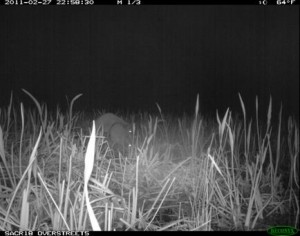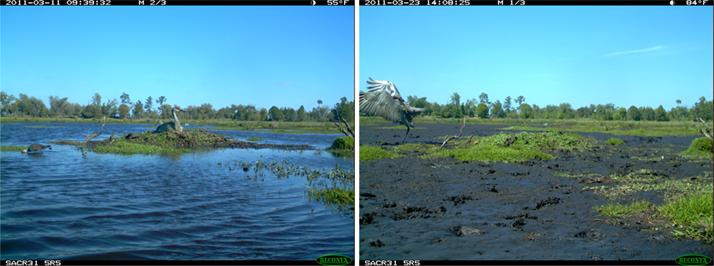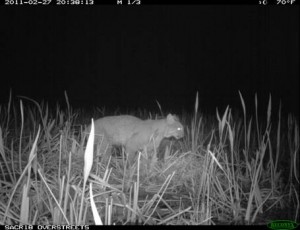 We continue to study the whooping cranes of the Florida resident flock. The flock contains 20 birds, 16 of which are paired. This spring we employed camera “traps” near nests of whooping and sandhill cranes in order to learn more about nesting issues. Camera traps, or trail-cameras as they are sometimes called, are cameras triggered by heat differential and motion. At night they use infrared “flash” to illuminate the photos. Wildlife cannot see the flash so it does not affect their behavior.
We continue to study the whooping cranes of the Florida resident flock. The flock contains 20 birds, 16 of which are paired. This spring we employed camera “traps” near nests of whooping and sandhill cranes in order to learn more about nesting issues. Camera traps, or trail-cameras as they are sometimes called, are cameras triggered by heat differential and motion. At night they use infrared “flash” to illuminate the photos. Wildlife cannot see the flash so it does not affect their behavior.
Most of our data so far are from sandhill crane nests and all results are preliminary. However, we are seeing some interesting results from the camera traps at nests. The cameras were useful for documenting 1) many occasions of visitors (representing disturbances or potential disturbances) to nests, 2) whether a nest was successful or not, 3) water levels at nests,and 4) behaviors of the birds at their nests. The following examples are presented in that order.
Camera traps successfullydocumented many disturbances or potential disturbances at nests. For one nest,the last image of the attending crane was when it flushed from the nest in the dark; and then a bobcat (Lynx rufus) walked by the nest.
While the nest was unattended, raccoons (Procyonlotor) came and scavenged the nest.
Raccoons were common near nests; at one nest they triggered the camera daily. Coyotes (Canis latrans) and an alligator (Alligator mississippiensis) also were photographed.
Sandhillcranes defended their nests from curious livestock, even when it meant dealing with an animal that weighed 200 times more than the crane.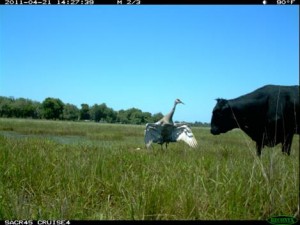
Camera traps also successfully documented whether nests hatched. Camera placement in relation to the nests provided clear views of chicks when they hatched.
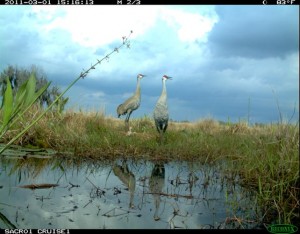
Also significant at this nest was the fact they were also incubating a data-logging egg that we had placed in their nest. The data recorded will provide a “known successful” recipe for incubation temperature.
Camera traps also documented water levels. This is important because too much water can flood nests and too little water will cause abandonment. One nest was unique in that the nest was constructed of mud and sticks on a natural rise in an otherwise open-water pond. Extremes in water level can be seen at this nest in the next picture.
Camera traps captured important bird behaviors. Last year we discovered from data-logging eggs that whooping cranes were sometimes leaving their nests unattended at night. This quarter we deployed the first-ever successful camera trap at a whooping crane nest.
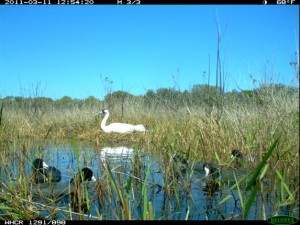
Important was the documentation of the pair exchanging incubation duties in the dark.
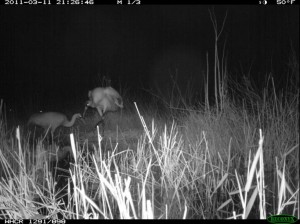
Of the trailcam photos from sandhill nests we reviewed thus far there have been no obvious nest exchanges at night. This could be a fundamental behavioral difference between the 2 species that previously has been undescribed (but we’ll need data from more whooping crane nests before we can say that). Or, it could be a behavioral artifact of captive rearing for the whooping cranes. Whatever the reason, it would seem to add vulnerability to the eggs and potentially attract attention to the nests of whooping cranes.
We ended the 2011 nesting season with data from 22 sandhill crane nests and 7 whooping crane nests. The results are still preliminary, but it is evident that these new techniques for studying nest success are providing exciting and valuable information about crane reproduction. We plan to continue the study next year to get more data, especially from whooping crane nests. This work was funded in part by the U.S.Fish and Wildlife Service.
Marty Folk, Florida Fish and Wildlife Conservation Commission.
